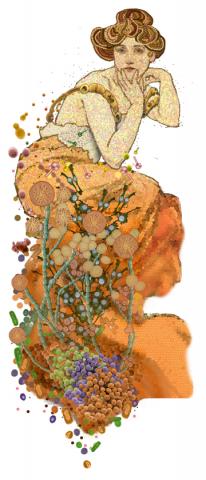
Image credit: Theme art photoshopped by William F. Discher after Alphonse Mucha.
By Andrea Frydl, Contributing Writer
The 18th annual Spring Research Festival (SRF) will take place May 5–8 at the NCI Campus at Frederick and Fort Detrick. This is the second year that the event is sponsored by the National Interagency Confederation for Biological Research (NICBR), an interagency committee made up of various research entities located within Fort Detrick.
Theme
The interaction between the microbial world (bacteria, viruses, and fungi) and its environment is constantly evolving. This evolution is affected by many factors, including the health status of the host and the localized conditions at the time of host–microbe interactions.
The theme of the 2014 NICBR SRF, “The Microbiome: Impact on Health & Disease,” aims at understanding the interactions between hosts, whether they are plant, animal, or human, and the microbial world, and elucidating the impact of these interactions on host well-being or disease processes.
Past SRF themes have included the fungus-growing ant and antitumor link (2013); the digger wasp and symbiosis with bacteria (2012); and the cone snail, which produces conotoxins that form the basis of powerful, nonaddictive painkillers (2004).
Festivities
The festival starts with two events held at the NCI Campus at Frederick conference center in the Building 549 auditorium: the NICBR Scientific Symposium, “The Microbiome: Host Response to Disease,” on May 5, and the NICBR Research Collaboration Forum on May 6.
The larger part of the festival begins May 7, when the main poster session kicks off with a keynote speaker and a poster blitz (several posters presented one after another in a timed format) from 9:30 to 11 a.m. in the Community Activity Center, Building 1529.
Poster presentations run from 10 a.m. to 2:30 p.m. on May 7 and 8.
In addition to scientific poster sessions, the exhibition will include booths with information on local agencies, educational opportunities, safety and scientific displays, as well as commercial exhibits of the latest scientific equipment and technologies.
Importance of Getting Involved
“The goal of the festival is to acquaint our neighbors—scientists, citizens, and especially students—with the nature of our research and to facilitate collaboration between partner agencies,” said Craig Reynolds, Ph.D., director, Office of Scientific Operations. “To meet this goal, members of the NICBR community are highly encouraged to get involved.”
How You Can Get Involved
- Present a scientific poster
If you are a scientist (or an aspiring scientist), consider submitting a poster presenting your research. All scientific staff members, including technical support, postdoctoral fellows, and investigators, are encouraged to present posters describing their research efforts.
Poster registrations are being accepted until April 18.
For more information about poster presentations or to register, visit the SRF Website. - Become a judge
The SRF committee needs members of the community to sign up as poster judges. “When you share your time in venues such as the Spring Research Festival, it promotes collaboration among established scientists and sets a standard for our young researchers to emulate. We thank you for volunteering,” Reynolds said.
For more information about judging requirements or how to register, visit the SRF Website. - Volunteer at your booth
Many NICBR and NCI at Frederick organizations will have booths in the SRF exhibit space. A complete listing of the agencies and programs exhibiting will be e-mailed to the NCI at Frederick community closer to the date of the event.
For more information about exhibits, visit the SRF Website.
Questions?
For general questions regarding the SRF, please contact the SRF administrator.
If you are experiencing technical difficulties with the SRF website, please contact the webmaster.
NICBR includes the following organizations colocated at Fort Detrick:
- United States Army Medical Research and Materiel Command (USAMRMC) and United States Army Medical Research Institute of Infectious Diseases (USAMRIID)
- National Institute of Allergy and Infectious Diseases (NIAID), Integrated Research Facility (IRF)
- National Cancer Institute at Frederick
- United States Department of Agriculture (USDA), Agricultural Research Service (ARS)
- United States Department of Homeland Security (DHS), National Biodefense Analysis and Countermeasures Center (NBACC)
- Centers for Disease Control and Prevention (CDC)
- United States Navy, Naval Medical Research Center (NMRC)
- U.S. Food and Drug Administration (FDA)
- United States Army, Installation Management Command

